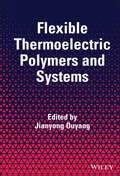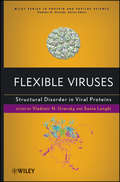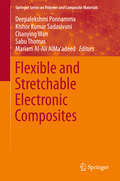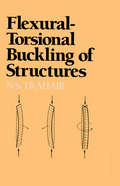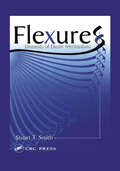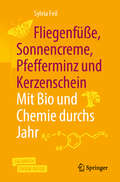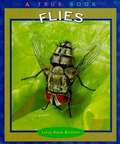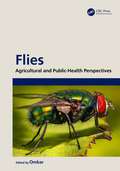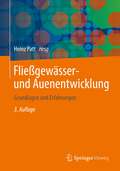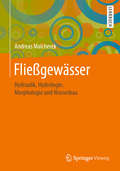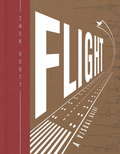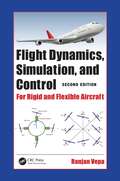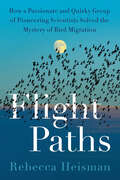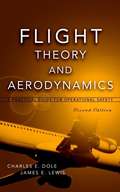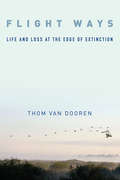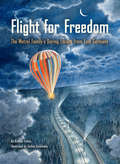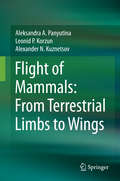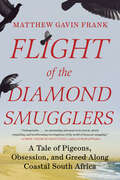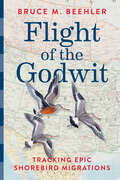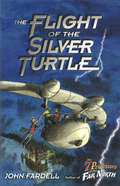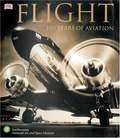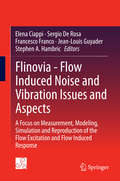- Table View
- List View
Flexible Thermoelectric Polymers and Systems
by Jianyong OuyangFlexible Thermoelectric Polymers and Systems Comprehensive review of the rapidly evolving field of flexible thermoelectric polymers Flexible Thermoelectric Polymers and Systems delivers an expansive exploration of the most recent developments in flexible thermoelectric polymers and composites, as well as their applications in thermoelectric generators and Peltier coolers. The book focuses on novel designs and applications of technologies such as low-dimensional thermoelectric materials and how the latest advances have begun to overcome problems including poor mechanical flexibility and high fabrication costs. The book begins with a review of the fundamentals of thermoelectric materials, including discussions of the properties of thermoelectric materials, the Seebeck, Peltier, and Thomson effects, electrical conductivity, thermal conductivity, and thermoelectric generators, cooling, and sensors. It goes on to discuss more advanced developments in the field, such as flexible thermoelectric plastics and the thermoelectric properties of conducting polymers with ionic conductors. The book also includes: Thorough introductions to thermoelectric materials and systems, as well as the chemistry and physics of intrinsically conductive polymers Comprehensive explorations of thermoelectric PEDOTs, p-type thermoelectric polymers, and N-type thermoelectric polymers Practical discussions of thermoelectric composites of carbon nanotubes, graphene, and nanomaterials In-depth examinations of polymer composites of inorganic thermoelectric semiconductors Perfect for academic and industrial researchers and engineers in physics, materials science, chemistry, and engineering, Flexible Thermoelectric Polymers and Systems is also an indispensable resource for graduate students and early-career professionals working in those fields.
Flexible Viruses
by Vladimir Uversky Sonia LonghiThis book provides up-to-date information on experimental and computational characterization of the structural and functional properties of viral proteins, which are widely involved in regulatory and signaling processes. With chapters by leading research groups, it features current information on the structural and functional roles of intrinsic disorders in viral proteomes. It systematically addresses the measles, HIV, influenza, potato virus, forest virus, bovine virus, hepatitis, and rotavirus as well as viral genomics. After analyzing the unique features of each class of viral proteins, future directions for research and disease management are presented.
Flexible and Stretchable Electronic Composites
by Sabu Thomas Deepalekshmi Ponnamma Mariam Al-Ali AlMa'adeed Kishor Kumar Sadasivuni Chaoying WanThis book is the first comprehensive collection of electronic aspects of different kinds of elastomer composites, including combinations of synthetic, natural and thermoplastic elastomers with different conducting fillers like metal nanoparticles, carbon nanotubes, or graphenes, and many more. It covers elastomer composites, which are useful in electronic applications, including chemical and physical as well as material science aspects. The presented elastomer composites have great potential for solving emerging new material application requirements, for example as flexible and wearable electronics. The book is structured and organized by the rubber/elastomer type: each chapter describes a different elastomer matrix and its composites. While introducing to important fundamentals, it is application-oriented, discussing the current issues and challenges in the field of elastomer composites. This book will thus appeal to researchers and scientists, to engineers and technologists, but also to graduate students, working on elastomer composites, or on electronics engineering with the composites, providing the readers with a sound introduction to the field and solutions to both fundamental and applied problems.
Flexural-Torsional Buckling of Structures (New Directions In Civil Engineering Ser. #6)
by N. S. TrahairFlexural-Torsional Buckling of Structures provides an up-to-date, comprehensive treatment of flexural-torsional buckling and demonstrates how to design against this mode of failure. The author first explains the fundamentals of this type of buckling behavior and then summarizes results that will be of use to designers and researchers in either equation or graphical form. This approach makes the book an ideal text/reference for students in structural engineering as well as for practicing civil engineers, structural engineers, and constructional steel researchers and designers. The book begins by introducing the modern development of the theory of flexural-torsional buckling through discussions on the general concepts of equilibrium, total potential, virtual work, and buckling. It then continues with in-depth coverage of hand methods for solving buckling problems, the analysis of flexural-torsional buckling using the finite element method, and the buckling of different types of structural elements and frames composed of various elastic materials. Other topics addressed include the design and inelastic buckling of steel members. The book's final chapter considers a collection of special topics.
Flexures: Elements of Elastic Mechanisms
by Stuart T. SmithThis book presents some basic flexure geometries and the analytic models, which can be assessed for specific design applications. The author then goes beyond this fundamental explanation to explore more sophisticated issues. Specifically, the text discusses integration of these flexure geometries and analytic models to produce useful mechanisms for
Fliegenfüße, Sonnencreme, Pfefferminz und Kerzenschein | Mit Bio und Chemie durchs Jahr
by Sylvia FeilWoher wissen Bäume, dass es Frühling ist? Wie wirkt Tageslicht auf der Haut? Was macht Frost mit Trauben? Was hat die Photosynthese mit Quantenphysik zu tun? Sind Ingwer und Kurkuma wirklich so gesund? Monat für Monat streifen Leserinnen und Leser mit diesem Buch durch die Jahreszeiten. Die Kapitel greifen interessante Phänomene aus der Natur auf und erklären ihre chemischen und biologischen Hintergründe.Am Jahresanfang lernen wir etwas über die Wirkung von Streusalz und wie Sonnenlicht gegen den Winterblues hilft, im Frühling begegnen uns im Moor sprießende Moose und klebrige Pflanzen, im Sommer erklärt die Autorin, wieso wir schwitzen und was man dagegen machen kann. Im Herbst werden Gewürzvorräte angelegt und die Weinernte beginnt – im Winter erleuchten uns Kerzenschein und Kometenschweife.
Flies: A True Book
by Larry Dane BrimnerDescribes the physical characteristics, behavior, and life cycle of flies and discusses some of the different kinds.
Flies: Agricultural and Public-Health Perspectives
by OmkarThe term "flies" applies to the insects belonging to the order Diptera, more commonly known as flies, gnats, midges, and leaf miners. They typically possess a pair of antennae, a set of sponging‑type mouthparts, two developed forewings for flight, and two hindwings which are used for aerial balance.Flies occupy unique and diverse roles within our ecosystem: some are pests which affect our agricultural and horticultural crops; other varieties act as vectors that spread diseases within the human and animal population. However, not all flies are harmful to humans: some species of fly play a role in facilitating crop pollination, whilst others are involved in environmental engineering, waste decomposition, and/or nutrient recycling, forming an important component of integrated pest management as effective biocontrol agents. Others even play a role in crime solving within the field of forensic entomology.Flies: Agricultural and Public-Health Perspectives has been planned with a holistic approach to highlight both the positive and negative aspects of flies. This book starts with a chapter on the introduction to flies, followed by insects of agricultural and horticultural importance, flies as vectors, and beneficial flies. Designed with ease of reader use in mind, each chapter includes "pointwise learning objectives" at the beginning, as well as "conclusions" and "points to remember" at the end.This book will be useful not only to students of entomology, public health, agriculture, and applied life sciences but also to those involved in policy planning and vector management. In addition, this book will benefit students preparing for competitive examinations as well as the public.
Fließgewässer- und Auenentwicklung: Grundlagen und Erfahrungen
by Werner Konold Peter Meyer Stephan Von Keitz Walter Binder Mario Sommerhäuser Michael Schirmer Klaus Arzet Birgit Beckers Hubertus Brückner Holger Brux Dieter Coldewey Alexandra Dehnhardt Ulrich Detering Sebastian Döbbelt-Grüne Joachim Drüke Thomas-Ols Eggers Klaus-Dieter Fröhlich Christian Göldi Josef Groß Anja Kaussow Ellen Kiel Uwe Koenzen Annette Kurth Roland Loerbroks Helmut Mader Dietmar Mehl Thomas Paulus Tanja Pottgieser Bernd Schackers Jörg Scholle Georg Schrenk Peter Sellheim Mechtild Semrau Simon Spinner Eberhard Städtler Bernd Walser Klaus Werk Michael WeyandDieses Fachbuch erläutert die Grundlagen für die Entwicklung von Fließgewässern und Gewässerauen und hilft dabei an den Erfahrungen der Autoren teilzuhaben. Aktuelle Vorgehensweisen zum Umgang mit einer dynamischen Gewässer- und Auenentwicklung werden nachvollziehbar dargestellt und durch zahlreiche Beispiele aus unterschiedlichen Gewässerlandschaften ergänzt. Zur Erreichung der ambitionierten Ziele der Europäischen Wasserrahmenrichtlinie (WRRL) sind die gewässerökologischen, naturschutzfachlichen und hydromorphologischen Bedingungen (u.a. Hoch- und Niedrigwasser) im Gewässerkörper und in den angrenzenden Bereichen (u.a. die Gewässerauen), bei der Planung und Gestaltung zu berücksichtigen. Eine ganzheitliche Betrachtungsweise ist dabei Grundvoraussetzung.
Fließgewässer: Hydraulik, Hydrologie, Morphologie und Wasserbau
by Andreas MalcherekDas vorliegende Buch vermittelt Studierenden die hydrologischen, hydraulischen und wasserbaulichen Grundlagen für Gerinne und Fließgewässer. Mit den Programmierbeispielen können die Inhalte geübt und vertieft werden.
Flight
by Zack ScottFlight is the story of humankind's most ambitious undertaking. From thousand-year-old flying machines and the trailblazing 'birdmen' who risked their lives to test them, to the Wright brothers' legendary first flight and the iconic spacecraft of the modern era, Flight weaves together the extraordinary history of aviation with an in-depth look at the mechanics of how planes work. Sumptuously illustrated and written by a former RAF technician, this is the definitive guide to how we conquered the skies.
Flight
by Zack ScottFlight is the story of humankind's most ambitious undertaking. From thousand-year-old flying machines and the trailblazing 'birdmen' who risked their lives to test them, to the Wright brothers' legendary first flight and the iconic spacecraft of the modern era, Flight weaves together the extraordinary history of aviation with an in-depth look at the mechanics of how planes work. Sumptuously illustrated and written by a former RAF technician, this is the definitive guide to how we conquered the skies.
Flight Dynamics, Simulation, and Control: For Rigid and Flexible Aircraft
by Ranjan VepaFlight Dynamics, Simulation, and Control of Aircraft: For Rigid and Flexible Aircraft explains the basics of non-linear aircraft dynamics and the principles of control-configured aircraft design, as applied to rigid and flexible aircraft, drones, and unmanned aerial vehicles (UAVs). Addressing the details of dynamic modeling, simulation, and control in a selection of aircraft, the book explores key concepts associated with control-configured elastic aircraft. It also covers the conventional dynamics of rigid aircraft and examines the use of linear and non-linear model-based techniques and their applications to flight control. This second edition features a new chapter on the dynamics and control principles of drones and UAVs, aiding in the design of newer aircraft with a combination of propulsive and aerodynamic control surfaces. In addition, the book includes new sections, approximately 20 problems per chapter, examples, simulator exercises, and case studies to enhance and reinforce student understanding. The book is intended for senior undergraduate and graduate mechanical and aerospace engineering students taking Flight Dynamics and Flight Control courses. Instructors will be able to utilize an updated Solutions Manual and figure slides for their course.
Flight Paths: How a Passionate and Quirky Group of Pioneering Scientists Solved the Mystery of Bird Migration
by Rebecca HeismanThe captivating, little-known true story of a group of scientists and the methods and technology they developed to uncover the secrets of avian migration.For the past century, scientists and naturalists have been steadily unravelling the secrets of bird migration. How and why birds navigate the skies, traveling from continent to continent—flying thousands of miles across the earth each fall and spring—has continually fascinated the human imagination, but only recently have we been able to fully understand these amazing journeys. Although we know much more than ever before, even the most enthusiastic birdwatcher may not know how we got here, the ways that the full breadth of scientific disciplines have come together to reveal these annual avian travels.Flight Paths is the never-before-told story of how a group of migration-obsessed scientists in the twentieth and twenty-first centuries engaged nearly every branch of science to understand bird migration—from where and when they take off to their flight paths and behaviors, their destinations and the challenges they encounter getting there. Uniting curious minds from across generations, continents, and disciplines, bird enthusiast and science writer Rebecca Heisman traces the development of each technique used for tracking migratory birds, from the first attempts to mark individual birds to the cutting-edge technology that lets ornithologists trace where a bird has been, based on unique DNA markers. Along the way, she touches on the biggest technological breakthroughs of modern science and reveals the almost-forgotten stories of the scientists who harnessed these inventions in service of furthering our understanding of nature (and their personal obsession with birds).The compelling and fascinating story of how scientists solved the great mystery of bird migration, Flight Paths is an unprecedented look into exciting, behind-the-scenes moments of groundbreaking discovery. Heisman demonstrates that the real power of science happens when people work together, focusing their minds and knowledge on a common goal. While the world looks to tackle massive challenges involving conservation and climate, the story of migration research offers a beacon of hope that we can find solutions to difficult and complex problems.
Flight Theory And Aerodynamics: A Practical Guide For Operational Safety
by James E. Lewis Charles E. DoleThe classic text for pilots on flight theory and aerodynamics now in an updated Second Edition Flight Theory and Aerodynamics, the basic aeronautics text used by the United States Air Force in their Flying Safety Officer course, is the book that brings the science of flight into the cockpit. Designed for the student with little engineering or mathematical background, the book outlines the basic principles of aerodynamics and physics, using only a minimal amount of high school level algebra and trigonometry necessary to illustrate key concepts. This expanded seventeen chapter Second Edition reflects the cutting edge of aeronautic theory and practice, and has been revised, reorganized, and updated with 30% new information including a new chapter on helicopter flight. Central to the book s structure is a clear description of aeronautic basics what lifts and drives an aircraft, and what forces work for and against it all detailed in the context of the design and analysis of today s aircraft systems: * Atmosphere and airspeed measurement * Airfoils and aerodynamic forces * Lift and drag * Jet aircraft basic and applied performance * Prop aircraft basic and applied performance * Slow and high-speed flight * Takeoff, landing, and maneuvering performance The book s practical, self-study format includes problems at the end of each chapter, with answers at the back of the book, as well as chapter-end summaries of symbols and equations. An ideal text for the USN Aviation Safety Officer and the USAAA s Aviation Safety Officer courses, as well as for professional pilots, student pilots, and flying safety personnel, Flight Theory and Aerodynamics is a complete and accessible guide to the subject, updated for the new millennium.
Flight Ways
by Thom Van DoorenA leading figure in the emerging field of extinction studies, Thom van Dooren puts philosophy into conversation with the natural sciences and his own ethnographic encounters to vivify the cultural and ethical significance of modern-day extinctions. Unlike other meditations on the subject, Flight Ways incorporates the particularities of real animals and their worlds, drawing philosophers, natural scientists, and general readers into the experience of living among and losing biodiversity.Each chapter of Flight Ways focuses on a different species or group of birds: North Pacific albatrosses, Indian vultures, an endangered colony of penguins in Australia, Hawaiian crows, and the iconic whooping cranes of North America. Written in eloquent and moving prose, the book takes stock of what is lost when a life form disappears from the world -- the wide-ranging ramifications that ripple out to implicate a number of human and more-than-human others. Van Dooren intimately explores what life is like for those who must live on the edge of extinction, balanced between life and oblivion, taking care of their young and grieving their dead. He bolsters his studies with real-life accounts from scientists and local communities at the forefront of these developments. No longer abstract entities with Latin names, these species become fully realized characters enmeshed in complex and precarious ways of life, sparking our sense of curiosity, concern, and accountability toward others in a rapidly changing world.
Flight Ways: Life and Loss at the Edge of Extinction
by Thom Van DoorenA leading figure in the emerging field of extinction studies, Thom van Dooren puts philosophy into conversation with the natural sciences and his own ethnographic encounters to vivify the cultural and ethical significance of modern-day extinctions. Unlike other meditations on the subject, Flight Ways incorporates the particularities of real animals and their worlds, drawing philosophers, natural scientists, and general readers into the experience of living among and losing biodiversity.Each chapter of Flight Ways focuses on a different species or group of birds: North Pacific albatrosses, Indian vultures, an endangered colony of penguins in Australia, Hawaiian crows, and the iconic whooping cranes of North America. Written in eloquent and moving prose, the book takes stock of what is lost when a life form disappears from the world -- the wide-ranging ramifications that ripple out to implicate a number of human and more-than-human others. Van Dooren intimately explores what life is like for those who must live on the edge of extinction, balanced between life and oblivion, taking care of their young and grieving their dead. He bolsters his studies with real-life accounts from scientists and local communities at the forefront of these developments. No longer abstract entities with Latin names, these species become fully realized characters enmeshed in complex and precarious ways of life, sparking our sense of curiosity, concern, and accountability toward others in a rapidly changing world.
Flight Ways: Life and Loss at the Edge of Extinction (Critical Perspectives on Animals: Theory, Culture, Science, and Law)
by Thom van DoorenA leading figure in the emerging field of extinction studies, Thom van Dooren puts philosophy into conversation with the natural sciences and his ethnographic encounters to vivify the cultural and ethical significance of modern-day extinctions. Unlike other meditations on the subject, Flight Ways incorporates the particularities of real animals and their worlds, drawing philosophers, natural scientists, and general readers into the experience of living among and losing biodiversity.Each chapter of Flight Ways focuses on a different species or group of birds: North Pacific albatrosses, Indian vultures, an endangered colony of penguins in Australia, Hawaiian crows, and the iconic whooping cranes of North America. Written in eloquent and moving prose, the book takes stock of what is lost when a life form disappears from the world—the wide-ranging ramifications that ripple out to implicate a number of human and more-than-human others. Van Dooren intimately explores what life is like for those who must live on the edge of extinction, balanced between life and oblivion, taking care of their young and grieving their dead. He bolsters his studies with real-life accounts from scientists and local communities at the forefront of these developments. No longer abstract entities with Latin names, these species become fully realized characters enmeshed in complex and precarious ways of life, sparking our sense of curiosity, concern, and accountability toward others in a rapidly changing world.
Flight for Freedom: The Wetzel Family's Daring Escape from East Germany
by Kristen FultonAn Inspiring True Story about One Family's Escape from Behind the Berlin Wall!Peter was born on the east side of Germany, the side that wasn't free. He watches news programs rather than cartoons, and wears scratchy uniforms instead of blue jeans. His family endures long lines and early curfews. But Peter knows it won't always be this way. Peter and his family have a secret. Late at night in their attic, they are piecing together a hot air balloon—and a plan. Can Peter and his family fly their way to freedom? This is the true story of a boy and his family who risk their lives for the hope of freedom in a daring escape from East Germany via a handmade hot air balloon in 1979.• A perfect picture book for educators teaching about the Cold War, the Iron Curtain, and East Germany• Flight for Freedom is a showcase for lessons of bravery, heroism, family, and perseverance, as well as stunning history• Includes detailed maps of the Wetzel family's escape route and diagrams of their hot air balloonFor fans of historical nonfiction picture books like Let the Children March, The Wall, Growing Up Behind the Iron Curtain, and Armstrong: The Adventurous Journey of a Mouse to the Moon.• True life escape stories• For readers age 5–9• For teachers, librarians, and historiansKristen Fulton is a children's book author. She can always be found with a notebook in hand as she ventures through historical sites and museums. Most of the time she lives in Florida—but she can also be found traveling the country by RV.Torben Kuhlmann is an award-winning children's book author and illustrator. Starting in kindergarten he became known as "the draftsman." Flying machines and rich historical detail often adorn his work. He lives in Hamburg, Germany.
Flight of Mammals: From Terrestrial Limbs to Wings
by Aleksandra A. Panyutina Leonid P. Korzun Alexander N. KuznetsovThis book offers a new explanation for the development of flight in mammals and offers detailed morphological descriptions of mammals with flapping flight. The skeletomuscular apparatus of the shoulder girdle and forelimbs of tree shrews, flying lemurs and bats is described in detail. Special attention is paid to the recognition of peculiar features of the skeleton and joints. For the basic locomotor patterns of flying lemurs and bats, the kinematic models of the shoulder girdle elements are developed. The most important locomotor postures of these animals are analyzed by means of statics. The key structural characters of the shoulder girdle and forelimbs of flying lemurs and bats, the formation of which provided transition of mammals from terrestrial locomotion to gliding and then, to flapping flight, are recognized. The concept is proposed that preadaptations preceding the acquisition of flapping flight could have come from widely sprawled forelimb posture while gliding from tree to tree and running up the thick trunks. It is shown that flying lemur is an adequate morphofunctional model for an ancestral stage of bats. The evolutionary ecomorphological scenario describing probable transformational stages of typical parasagittal limbs of chiropteran ancestors into wings is developed.
Flight of the Diamond Smugglers: A Tale Of Pigeons, Obsession, And Greed Along Coastal South Africa
by Matthew Gavin Frank“Unforgettable. . . . An outstanding adventure in its lyrical, utterly compelling, and heartbreaking investigations of the world of diamond smuggling.” —Aimee Nezhukumatathil For nearly eighty years, a huge portion of coastal South Africa was closed off to the public. With many of its pits now deemed “overmined” and abandoned, American journalist Matthew Gavin Frank sets out across the infamous Diamond Coast to investigate an illicit trade that supplies a global market. Immediately, he became intrigued by the ingenious methods used in facilitating smuggling?particularly, the illegal act of sneaking carrier pigeons onto mine property, affixing diamonds to their feet, and sending them into the air. Entering Die Sperrgebiet (“The Forbidden Zone”) is like entering an eerie ghost town, but Frank is surprised by the number of people willing—even eager—to talk with him. Soon he meets Msizi, a young diamond digger, and his pigeon, Bartholomew, who helps him steal diamonds. It’s a deadly game: pigeons are shot on sight by mine security, and Msizi knows of smugglers who have disappeared because of their crimes. For this, Msizi blames “Mr. Lester,” an evil tall-tale figure of mythic proportions. From the mining towns of Alexander Bay and Port Nolloth, through the “halfway” desert, to Kleinzee’s shores littered with shipwrecks, Frank investigates a long overlooked story. Weaving interviews with local diamond miners who raise pigeons in secret with harrowing anecdotes from former heads of security, environmental managers, and vigilante pigeon hunters, Frank reveals how these feathered bandits became outlaws in every mining town. Interwoven throughout this obsessive quest are epic legends in which pigeons and diamonds intersect, such as that of Krishna’s famed diamond Koh-i-Noor, the Mountain of Light, and that of the Cherokee serpent Uktena. In these strange connections, where truth forever tangles with the lore of centuries past, Frank is able to contextualize the personal grief that sent him, with his wife Louisa in the passenger seat, on this enlightening journey across parched lands. Blending elements of reportage, memoir, and incantation, Flight of the Diamond Smugglers is a rare and remarkable portrait of exploitation and greed in one of the most dangerous areas of coastal South Africa. With his sovereign prose and insatiable curiosity, Matthew Gavin Frank “reminds us that the world is a place of wonder if only we look” (Toby Muse).
Flight of the Godwit: Tracking Epic Shorebird Migrations
by Bruce M. BeehlerSoar across 46 North American territories to uncover the secrets of 7 magnificent shorebirds, the world&’s greatest nonstop travelersAn immersive travelogue that belongs on every birder's bookshelf, with 30 gorgeous black-and-white illustrations and a birdwatching species checklistFlying more than 8,000 miles from Alaska to eastern Australia without stopping to eat or rest, the Bar-tailed Godwit holds the record for the longest nonstop migration of any land bird in the world. Flight of the Godwit invites readers on ornithologist Bruce M. Beehler's awe-inspiring journey in search of North America's largest and farthest-flying shorebirds. Driving 35,000 miles between 2019 to 2023, Beehler sought birds he dubs the "Magnificent Seven": Hudsonian GodwitBar-tailed GodwitMarbled GodwitWhimbrelLong-billed CurlewBristle-thighed CurlewUpland SandpiperBeehler interweaves colorful fieldwork stories and rich details on local culture with the natural history and biology of shorebirds—including evolution, the physics of migration, orientation, homing, foraging, diet, nesting, parental care, wintering, staging, elusive "super-migrators," and the importance of conservation efforts.With authoritative prose and 30 beautiful black-and-white illustrations from artist Alan T. Messer, the book journeys through 37 states and 9 Canadian provinces from Texas to Alaska to Canada's High Arctic. Flight of the Godwit is a captivating adventure and a tribute to remarkable birds and birding itself.
Flight of the Silver Turtle
by John FardellThe take-charge kids from John Fardell's The 7 Professors of the Far North face a summer packed with danger, excitement and suspense--flying airplanes, scuba diving, cracking codes and even taking a spin in the world's first antigravity backpack as they plunge into this fast-paced, high- flying adventure. Ben, Zara, Sam and Marcia begin their summer vacation by helping Professor Ampersand build the Silver Turtle, a high-tech airplane. This is thrilling enough, but things take an even wilder turn when a strange woman steals the airplane with the kids inside. She's trying to evade members of Noctarma, an international criminal organization that thinks the airplane is carrying a secret antigravity device that could be the key to world domination. They've got the wrong Silver Turtle, but they've also captured Professor Ampersand--and the kids will have to pull out all the stops to find the real Silver Turtle device before Noctarma does.
Flight: 100 Years of Aviation
by R. G. GrantThis groundbreaking book charts the inspirational story behind humankind's conquest of the skies. From record-breaking flights and aerial warfare, to advances in aircraft design and the race for space, Flight covers the most memorable moments in the history of aviation. Flight is a gripping narrative of humankind's quest to conquer the skies and explore space.
Flinovia - Flow Induced Noise and Vibration Issues and Aspects
by Jean-Louis Guyader Stephen A. Hambric Elena Ciappi Sergio De Rosa Francesco FrancoFlow induced vibration and noise (FIVN) remains a critical research topic. Even after over 50 years of intensive research, accurate and cost-effective FIVN simulation and measurement techniques remain elusive. This book gathers the latest research from some of the most prominent experts in the field. It describes methods for characterizing wall pressure fluctuations, including subsonic and supersonic turbulent boundary layer flows over smooth and rough surfaces using computational methods like Large Eddy Simulation; for inferring wall pressure fluctuations using inverse techniques based on panel vibrations or holographic pressure sensor arrays; for calculating the resulting structural vibrations and radiated sound using traditional finite element methods, as well as advanced methods like Energy Finite Elements; for using scaling approaches to universally collapse flow-excited vibration and noise spectra; and for computing time histories of structural response, including alternating stresses. This book presents the proceedings of the First International Workshop on Flow Induced Noise and Vibration (FLINOVIA), which was held in Rome, Italy, in November 2013. The authors' backgrounds represent a mix of academia, government, and industry, and several papers include applications to important problems for underwater vehicles, aerospace structures and commercial transportation. The book offers a valuable reference guide for all those working in the area of flow-induced vibration and noise.
